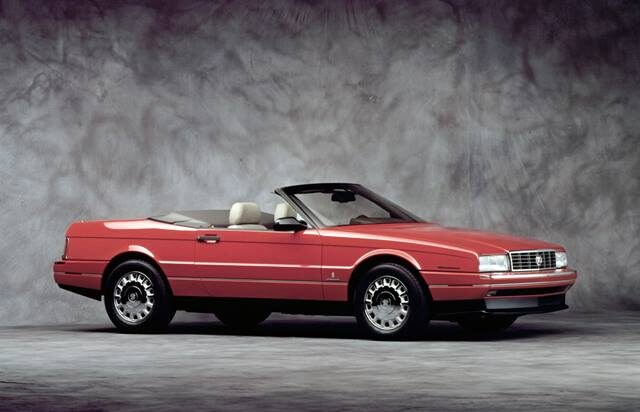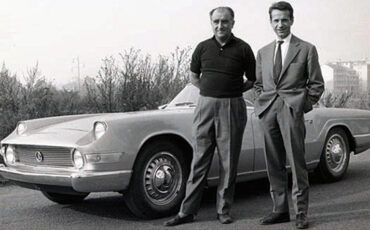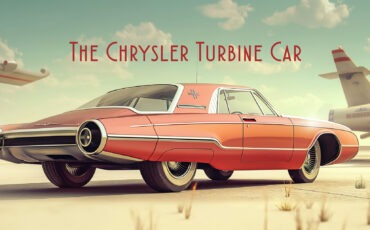
What if creating a world-class luxury car required an assembly line stretching across the Atlantic? This was the bold challenge Cadillac faced with the Allanté, a sleek roadster designed by Pininfarina and built through one of the most ambitious logistical feats in automotive history. In this article, we’ll uncover the fascinating story of the “Allanté Airbridge,” a production strategy so unique that it remains unmatched to this day.
The Birth of the Allanté – A Cadillac Like No Other
The Cadillac Allanté is a standout in automotive history, symbolizing true innovation. While it wasn’t the first Cadillac designed by Pininfarina, it was the first official collaboration between Cadillac and the renowned Italian design house. This partnership brought together American luxury and European craftsmanship in a way that was truly groundbreaking.
To dive deeper into the story of the Italian Cadillacs, be sure to check out our special article here.
In the early 1980s, General Motors (GM) found itself facing a critical problem: its Cadillac brand was losing its appeal. The ultra-luxury car market was increasingly dominated by European manufacturers, with younger and middle-aged American buyers shifting their attention toward brands like Mercedes-Benz, Jaguar, Porsche, and BMW. Cadillac, once the symbol of American automotive luxury, had to regain its prestige quickly. The solution? A complete rethinking of what the Cadillac brand could offer.

GM turned to Sergio Pininfarina, the head of the world-famous Italian design house Carrozzeria Pininfarina. Pininfarina’s reputation for creating elegant and aerodynamic cars made him the perfect choice to design Cadillac’s new flagship model. But it wasn’t just about designing a car—it was about building a luxury vehicle that would evoke European sophistication while still maintaining the American luxury Cadillac was known for.
In addition to designing the car, Pininfarina’s company was also tasked with building and painting the bodies at a newly established facility in San Giorgio Canavese, Italy. GM hoped that this “Made in Italy” operation would give the Allanté a touch of European exclusivity and sophistication, ultimately helping Cadillac reestablish itself in the competitive luxury market.
The project was born out of the desire to compete with European roadsters like the Mercedes-Benz SL-Class and Jaguar’s XJ-S coupé, which had been drawing away Cadillac’s traditional younger, affluent clientele. With this in mind, GM set out to create a luxury two-seat roadster that would reflect the elegance of its European competitors but still carry the distinct presence of Cadillac.

After much deliberation, GM chose the name “Allanté” for the new model, which was selected from over 1,700 computer-generated suggestions. The name was meant to convey a sense of class and adventure, aligning with the car’s intended image as Cadillac’s “new passenger car flagship.”
In 1982, Cadillac approached Pininfarina with the challenge of designing a luxury two-seater that could compete with the likes of European roadsters. The design concept was initially quite free-form, with no fixed ideas, but soon the specifics began to take shape. Cadillac wanted something that felt both sporty and luxurious, but also unmistakably American in style. The result was a design that integrated sleek European flair with the reliability and comfort that Cadillac was known for.
By the end of 1982, Pininfarina had presented five concept models, each with its own unique approach to the final vision. Two of these models stood out: one with a more classical design and the other with a bold, aerodynamic look. Ultimately, Cadillac chose the more traditional model, which featured influences from the aerodynamically inclined prototype. This decision set the stage for what would become one of the most iconic luxury cars of the 80s.


The Stola company created the Master Model, framework models, interior models, resin copies for molds, and control gauges for the Allanté. In 1984, the Allanté became the first project fully realized through CNC milling. From then on, the Stola workshop at Via La Thiule 69/71 shifted from handcrafting master models to using CNC technology for all production.
The development process was swift, with the exterior and interior designs finalized by mid-1983. The car’s body was to be produced in Italy, while the engineering and assembly work would be handled in the U.S. General Motors approved the final design in 1984, and by 1985, the Allanté was ready to be seen on the road.
A New Image for Cadillac – Luxury Meets European Elegance
The Allanté wasn’t just a new car, it was a reimagining of what Cadillac could be. At the time, Cadillac had been struggling to maintain its position as the “standard of the world” in a market that was rapidly changing. In particular, younger American buyers were increasingly drawn to European cars, with their sleek designs and performance-oriented engineering. Cadillac needed a car that could appeal to this new generation while still retaining its luxurious, larger-than-life appeal.
The Allanté’s design was aimed at achieving just that. Cadillac wanted a car that would showcase the brand’s storied history while also appealing to a more modern, stylish audience. The challenge for Pininfarina was to create a car that was unmistakably Cadillac, with all the luxury and presence that the brand demanded, but with a more contemporary, European-inspired aesthetic.
The design was a delicate balance between presence and sophistication. Cadillac wanted the Allanté to be bold, but not in an overtly flashy way. The final design was sleek and imposing, with a front grille that paid homage to Cadillac’s signature look but with a more modern twist. The rear of the car was similarly bold, with a design that not only looked striking but also helped improve the car’s aerodynamics.

One of the most notable aspects of the Allanté’s design was the innovative use of glazing. Pininfarina crafted a seamless, continuous surface between the windshield, side windows, and rear window. This created a visually stunning effect, making the car look more fluid and elegant. These themes had already been introduced on the Ferrari Pinin in 1980 and on the Audi Quartz, but it was the first time implemented it in mass production. The rear tail design was also refined to enhance the car’s aerodynamic performance while maintaining its luxurious look.
The interior of the Allanté was designed with a similar focus on elegance and comfort. It combined the best of both worlds: the sophistication of European ergonomics with the grandeur that American buyers were accustomed to. The cabin was filled with luxurious materials, including fine leather, and the layout was designed to offer maximum comfort, with plenty of space and high-tech features.
While Cadillac’s traditional clientele may have found the design a bit too avant-garde at first, it was clear that the Allanté was the future of the brand. It was the car that would lead the way for a new generation of Cadillacs, and it certainly lived up to that promise.
Engineering Excellence – Aerodynamics and Design Challenges
The Allanté wasn’t just about good looks; it was about performance, too. With its sleek design and modern engineering, the car had to offer both style and substance. One of the biggest challenges in the design process was ensuring that the car’s shape would not only look good but also perform well on the road. This meant paying close attention to aerodynamics, something that was often overlooked in luxury cars at the time.

In wind tunnel tests, the Allanté’s design proved to be incredibly effective, with a drag coefficient (Cx) of 0.34 when using the hardtop. With the soft top on, the Cx increased slightly to 0.37, which was still impressive for a car of this style. Pininfarina worked tirelessly to ensure that the Allanté’s design minimized wind noise and turbulence, even at higher speeds. The result was a car that was not only beautiful but also a pleasure to drive, even on the highway. With the top down, the Allanté offered a quiet, smooth ride, allowing passengers to enjoy the open air without the discomfort of strong winds or noise.
The engineering challenges didn’t stop with aerodynamics. The decision to go with a front-wheel-drive layout was another significant move that would shape the Allanté’s performance. This layout provided the car with better traction and handling, especially in slippery conditions. It also allowed for a lower engine hood and a more comfortable cabin layout, something that was essential for a luxury car.
The body of the Allanté was built using a mix of materials, including aluminum for the doors and hood. The bumpers were made from a durable plastic called Xenoy, which was designed to withstand low-speed impacts. While plastic materials were considered for other parts of the car, Pininfarina decided to stick with more traditional materials for the body, as they offered better durability and finish.

Inside the car, Cadillac’s engineering team worked hard to integrate cutting-edge technology without compromising on comfort. The Allanté featured a mix of high-tech features and traditional luxury elements, like its finely crafted leather seats and classic dashboard layout. While the interior was designed with European ergonomics in mind, Cadillac’s influence was evident in the spacious, comfortable cabin.
The Allanté was a perfect example of how a car could combine world-class design, advanced engineering, and cutting-edge technology, all while staying true to the luxury heritage of its brand. It wasn’t just a car; it was a statement of what Cadillac could achieve when it pushed the boundaries of innovation.
The Allanté Airbridge
One of the most remarkable aspects of the Cadillac Allanté’s production process was the innovative solution GM created to bridge the gap between two continents—the “Allanté Airbridge.” With the production split between the United States and Italy, GM faced a significant logistical challenge: the 4,000-mile Atlantic Ocean separated the two assembly plants. Traditional shipping methods were deemed too slow and unreliable, taking 24 days to transport the cars. In contrast, air freight could cut this time down to a mere eight hours, but it came with its own set of challenges.
To make this bi-continental production system work, GM needed to think creatively. The solution was an ambitious and costly plan to use dedicated air transport to deliver car parts and bodies between Detroit and Turin, while still maintaining the “just-in-time” manufacturing model. This approach ensured that components arrived quickly, and inventory was kept to a minimum, only amounting to the equivalent of one planeload of cars at any given time.

The plan involved some extraordinary logistics. The assembly process began at GM’s Detroit-Hamtramck Assembly Center, where workers would fit the air conditioning system, dashboard, and electrical systems to the chassis. These sub-assembled car bodies were then flown to Italy via specially configured Boeing 747 freighters. From Detroit’s Metropolitan Wayne County Airport, the bodies made their way to Turin-Caselle Airport in Italy. Once they arrived, the bodies were transported by truck to the Pininfarina facility in San Giorgio Canavese, about 20 miles northeast of Turin, where the painted bodies would be married with their interiors. Once completed, the cars were flown back to Detroit for final assembly, where GM installed the engine, gearbox, suspension, and other mechanical components.
This cross-continental manufacturing operation was nothing short of revolutionary, and on December 4, 1985, a landmark agreement was signed between GM, Alitalia, and Lufthansa to establish the Allanté Airbridge. The deal, valued at over $100 million, was signed aboard an Alitalia 747 aircraft parked at Detroit Metropolitan Airport. GM’s vice president, John O. Grettenberger, heralded the agreement as “the longest automotive assembly line in the world,” adding that Cadillac’s approach to luxury car production was setting a new precedent.
The airbridge plan was not without its complexities. Each week, up to three flights a week were scheduled to transport as many as 56 car bodies on each Boeing 747. The contract awarded to Lufthansa and Alitalia was based not only on cost but also on the airlines’ ability to deliver reliability and the best possible service. This was crucial in ensuring that the production process would not suffer delays. Backup aircraft and contingency plans for bad weather were also in place, given the often foggy winters in Turin.
The 747s used to transport the car bodies were fitted with specialized aluminum cradles, designed to securely hold the vehicles during flight. These cradles were developed through a collaborative effort between GM, Alitalia, and Boeing, and they were certified by both the U.S. Federal Aviation Administration and Italy’s Registro Aeronautico Italiano. Each 747 carried 22 double and 11 single cradles, which were carefully stowed on the aircraft. To ensure quick and safe handling, the airports at both ends of the journey were equipped with the latest infrastructure, and the cargo operations were streamlined for maximum efficiency.

The airbridge system ran with military precision. In fact, GM made substantial investments in Turin’s airport to ensure it could accommodate the new operation. The city’s airport lacked advanced navigation systems at the time, so GM demanded the installation of a new Instrument Landing System (ILS) to guarantee aircraft could land in low-visibility conditions. The resulting system, installed in 1985, was the first Category IIIb system in Italy and allowed flights to land in near-zero visibility conditions, crucial for operating during the foggy winter months.
In addition to the necessary air and ground infrastructure, a dedicated cargo facility was constructed at Turin-Caselle Airport. This warehouse, which covered over 19,000 square feet, was used to store the Allanté bodies until they could be loaded onto the aircraft. Specialized transportation carts were also built to ensure the cradles were handled safely and efficiently between the warehouse and the airplanes.
By 1986, flights between Detroit and Turin were underway, and the airbridge had become a vital part of the Allanté’s production process. Over the next two years, GM’s plan proved to be incredibly successful. No vehicle or component was damaged, and there were no delays in production caused by the airbridge system. It was a logistical success that supported the production of the Cadillac Allanté, but as with any ambitious project, the costs were significant.
Despite the high cost of the airbridge and the initial overestimation of the Allanté’s market demand, the production process ultimately slowed down. By 1988, GM had reduced the number of flights, and Lufthansa’s involvement in the project was phased out. Nevertheless, Alitalia continued to operate the airbridge, flying bodies to the U.S. twice a week, keeping the production line alive.

In 1993, the final Allanté body was flown from Turin to Detroit, and just two weeks later, production officially ended. While the Allanté didn’t live up to its initial expectations in terms of sales, the airbridge itself was an extraordinary achievement in global manufacturing logistics. Over the course of its seven-year run, the airbridge flew with regularity and precision, transporting thousands of car bodies and parts across the Atlantic. Even today, it remains one of the most ambitious and complex automotive production systems ever undertaken.
Would an Airbridge Be Possible Today? A Reflection
Looking back, the Allanté Airbridge was a remarkable feat of engineering and logistics, but could something similar be done today? Given modern concerns over sustainability and cost efficiency, the answer is highly unlikely.

From an economic standpoint, air freight is vastly more expensive than sea transport, and in an era where automakers are focused on streamlining costs, a transatlantic assembly line would be seen as impractical. Furthermore, the global shift toward environmental responsibility means that the carbon footprint of flying car bodies across the ocean would be heavily scrutinized. With sustainability now at the forefront of the industry, manufacturers prioritize localized production to reduce emissions and logistical complexities.
The Allanté Airbridge was a bold experiment—one that ultimately proved unsustainable, but still stands as an unparalleled testament to Cadillac’s ambition and Pininfarina’s craftsmanship.
Photos courtesy of: GM, Studiotorino, Cadillac.




